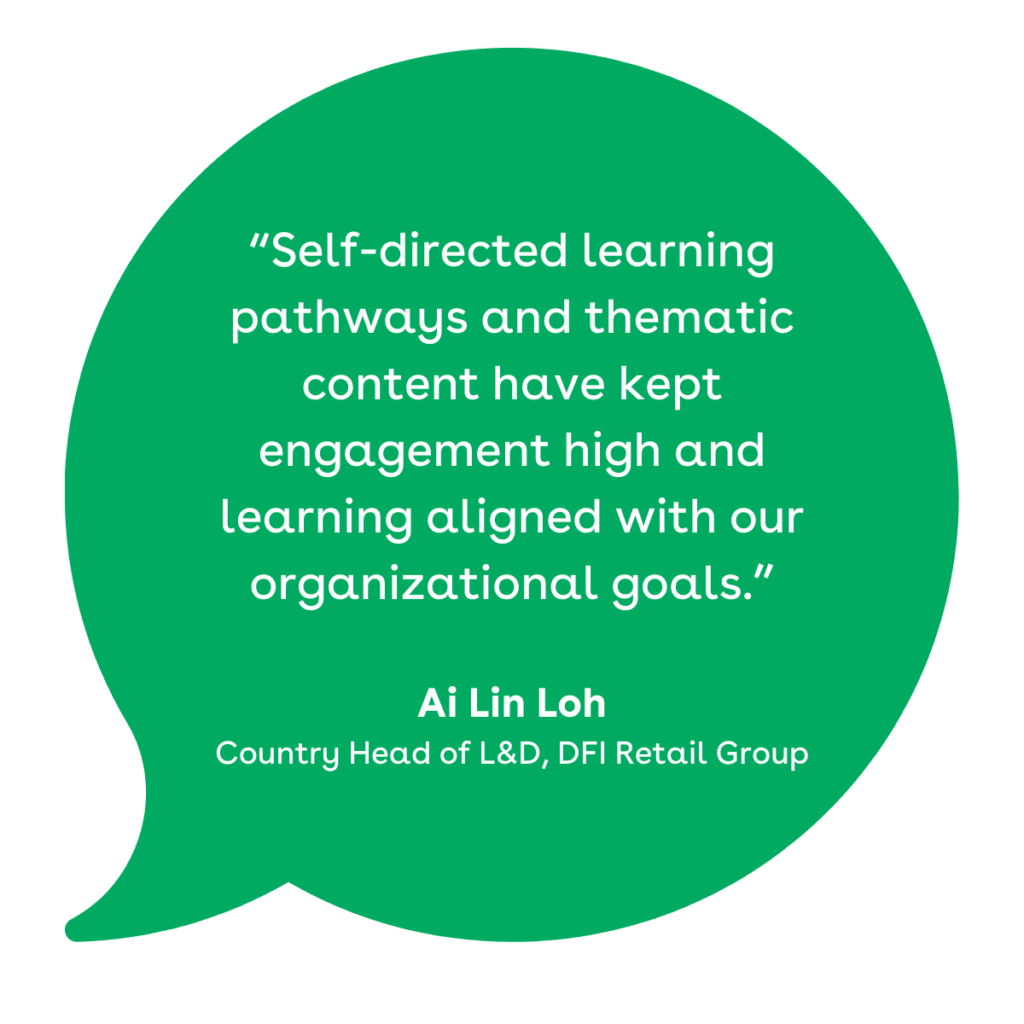How to implement an LMS: A practical guide
Rolling out a new learning management system (LMS) is a high-stakes move, especially when you’re supporting a deskless, distributed and fast-moving workforce. Your team’s success hinges on more than just launching a new LMS platform with the right functionality. It’s about enabling the right people, processes and content so that training becomes a seamless part of your learners’ day-to-day reality.

For frontline organizations, a successful LMS implementation requires careful planning, continuous improvement and a sharp focus on real-world opportunities like mobile access, shift schedules and diverse learning needs.
Whether you’re transitioning from an outdated system or starting from scratch, this guide will walk you through the key phases of an effective rollout and offer inspiring lessons from Axonify’s 1,000+ LMS implementation projects with companies like Knix, Walmart and DFI Retail Group.
In this article
1. Build the right team and set clear goals
Before you think about software configuration or course content, build your LMS implementation team. A successful implementation isn’t a solo act; it’s a cross-functional initiative involving L&D, IT, operations and business leaders. The right team members can drive alignment, avoid bottlenecks and ensure your LMS implementation plan maps directly to your organizational goals.
Implementation is a cross-functional effort, not just an IT or L&D project. It takes collaboration from several internal stakeholders to launch effectively and sustain momentum.
Key LMS implementation team roles:
| Role | Role description |
|---|---|
| Executive sponsor | Senior leader who champions Axonify within the organization, ensuring buy-in and ongoing support. |
| Project management lead/Implementation lead | Main point of contact for the rollout, responsible for platform configuration and program direction (content, rewards, etc.) |
| Technical/security lead | Oversees user management, authentication, security and integrations, ensuring IT readiness and support. |
| Content lead/SME | Guides custom content creation, approving all content-related decisions to ensure alignment with business needs. |
| Change management lead | Develops and executes the communication and engagement strategy to drive adoption. |
| Axonify administrator | Manages the platform’s administration, program creation and maintenance to sustain long-term success. |
Axonify tip: The timeline to implement an LMS can vary based on resources, complexity and goals. At Knix, a well-structured team helped the brand launch Axonify in a record 8 weeks.
Clear ownership, internal alignment and a strong partnership made this ambitious timeline possible, reinforcing just how important the right team is to successful implementation.

2. Take a phased, people-first approach to rollout
Rolling out an LMS is more than a technical project—it’s a shift in how people learn and work. A staged rollout helps to minimize disruption, build confidence with end-users and give your implementation team space to adapt as needed. Success depends on how well you understand the realities of their day-to-day work, especially for frontline teams.
A typical phased rollout includes:
Discovery and alignment
Start by identifying your business challenges, training goals and audience needs. Get clear on what success looks like, whether it’s improved onboarding speed, compliance completion rates or reduced safety incidents.
This phase lays the foundation. It’s where you identify who you’re supporting, what success looks like and how learning will fit into the flow of work. For frontline teams, this often means understanding shift patterns, device access and biggest operational pain points.
- Define your learning goals and business outcomes
- Map out user roles and frontline realities
- Align with stakeholders across L&D, Ops, IT and HR
- Set success metrics, like onboarding time, training completion or performance improvements
- Capture all of this in a shared implementation checklist
Platform setup and integration
A smooth learner experience starts with the right setup. This stage ensures your LMS is configured to reflect how your business operates and how your people work. In frontline environments, it’s important to flag early if learners share devices or lack regular desktop access so you can tailor the configuration accordingly.
- Configure user provisioning and roles
- Ensure SCORM or xAPI compatibility
- Set up single sign-on (SSO)
- Apply your brand elements for a consistent experience
- Connect the LMS with HRIS, CRM or scheduling tools
Content development and testing
Content makes learning feel useful. If it’s relevant, accessible and timely, people will return to the content when they need it. Start with topics that solve urgent business needs—like onboarding, product knowledge, task management or safety protocols. Test content with a small group to ensure it’s clear and mobile-friendly.
When you’re short on time or resources, consider repurposing existing assets or tapping into your vendor’s content support. Microlearning and mobile-first design are essential for frontline teams.
- Prioritize topics that’ll help you meet top business priorities efficiently.
- Reuse or adapt existing content where it makes sense
- Lean into proven formats like short videos or scenario-based quizzes
- Build a content calendar for the first 90 days
Communication and engagement planning
Frontline workers are busy and don’t always have time to explore a new tool so you need to give them a reason to log in. After all, your LMS launch should feel like a team initiative, not just a software update. A solid engagement plan builds momentum and shows employees what’s in it for them.
- Kick off with teaser videos or launch events
- Use frontline-friendly channels like manager huddles and QR codes
- Share clear login instructions and what to expect
- Equip managers to reinforce the value and answer questions
▶️ Related: Lessons in successful (and sustainable) change management
Pilot and early support
Go live with a small group first so you can test, learn and improve. Early feedback helps you identify friction points and refine before scaling. Consider hosting quick drop-in sessions or creating a “cheat sheet” for managers to answer common questions on the floor.
- Pilot with a group that reflects your broader user base
- Offer simple tutorials, walkthroughs or peer support
- Monitor logins, completions and help requests closely
- Be ready to adjust your approach based on what you hear
3. Make content creation a strategic priority
Content can make or break user adoption. That’s why a learning content strategy should be a foundational part of your LMS implementation plan, not an afterthought.
Here’s how to streamline your approach:
- Start small and scale. Launch with a few high-priority modules aligned to your business goals, then expand over time.
- Focus on accessibility. Design content for mobile use, reinforce learning in short bursts and reflect real work scenarios.
- Use varied formats. Mix job aids, videos, microlearning modules and assessments to improve engagement and retention.
- Align to real outcomes. Each training item should close a knowledge gap or support a workflow—not just tick a compliance box.
- Create feedback loops. Allow learners to rate and comment on content, so you can optimize in real time.

Axonify tip: The Learning Content Manager (LCM) team at Axonify partners with customers to digitize legacy materials, build learning paths and coach teams on scalable content development so they’re connected to the ideal outcomes for each organization.
Grab your copy of the Microlearning Guide for expert insights, practical tips and real-world examples of how microlearning drives results on the frontline.
4. Keep optimizing after launch
Your LMS requires continuous fine-tuning to stay relevant, especially for frontline employees who deal with daily operational changes, shifting customer expectations and evolving safety protocols. Once you launch, the focus shifts to ensuring the LMS meets real-time needs in the flow of work and delivers measurable outcomes.
To get there, commit to ongoing optimization across five key areas:
- Usage monitoring: Go beyond surface-level metrics and look at how different roles, shifts and locations engage with training. This helps surface trends, flag gaps early and focus support where it’s needed.
- Feedback loops: Actively collect feedback from employees and managers through in-platform surveys, informal conversations, coaching check-ins and frontline team huddles. Then, use that data to adjust content, clarify expectations or address barriers to access.
- Content agility: Training content must keep up with what’s happening on the floor. That includes product or customer protocol changes or compliance updates. A good LMS lets you quickly adapt, publish and measure the impact of updates without weeks of delay.
- Consistent reinforcement: Knowledge fades fast when it isn’t used (hello, forgetting curve). Frequent, short learning moments—ideally embedded into the daily routine—help strengthen retention and shift behavior on the job.
- Recognition and visibility: Employees are more likely to stick with training when it’s clearly connected to success. Recognizing completions, showcasing team achievements and celebrating performance improvements helps maintain momentum.
What continuous optimization looks like in action
| Optimization strategy | What it looks like in practice | Business impact |
|---|---|---|
| Track engagement by role/location | BorgWarner uses detailed reporting to track participation across various departments, helping managers identify where to focus coaching and support. | 98% participation rate; 95% compliance with the help of the competency program |
| Use feedback to refine approach | goeasy managers track completion and performance data, then use it to guide 1:1 conversations and tailor coaching based on individual needs. | 98% training completion; 12% increase in employee engagement |
| Refresh content regularly | Marriott International’s learning team continuously updates microlearning content to reflect real-world customer scenarios, seasonal offerings and brand standards. | 20% boost in role-specific knowledge; improved customer experience scores |
| Build learning into the flow of work | Kroger integrates 3-5 minute learning bursts into frontline shift routines, ensuring consistent reinforcement without pulling associates off the floor. | Sustained training adoption and behavior change across 350,000+ associates |
| Recognize effort and impact | Taziki’s Mediterranean Cafe uses dashboards, recognition pins and internal communications to highlight top-performing teams and celebrate completion milestones across locations. | Increased visibility and buy-in from both managers and frontline employees |
The right LMS implementation is about more than technology
A learning platform can have all the right features and still fail without a strong implementation behind it. That’s why leading organizations focus just as much on the how as the what.
Set clear goals. Involve the right people. Build great content. Communicate often. And keep optimizing.
Whether you’re working with a partner like Axonify or managing implementation internally, these best practices will help you avoid common pitfalls and set your workforce up for success, from Day 1 and beyond.
See how thousands of organizations have rolled out Axonify with ease and are achieving business results.
Schedule a demo to learn how we support successful implementation—so your frontline gets what they need, faster.